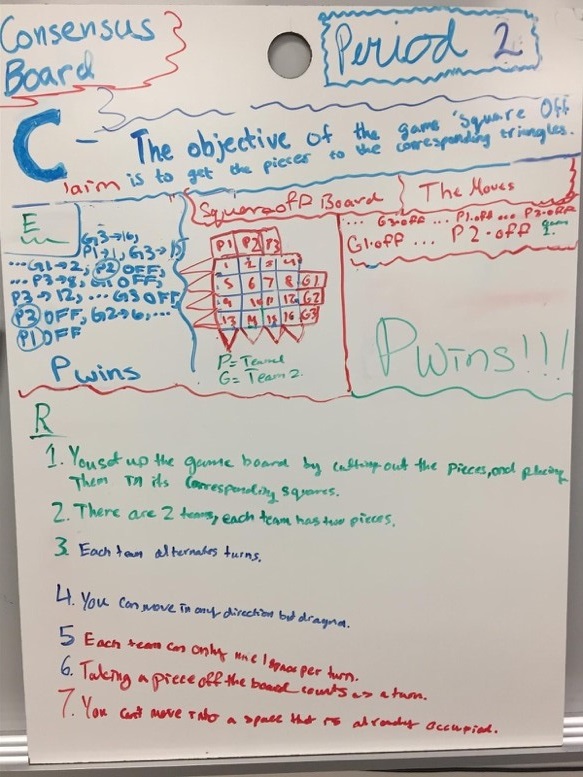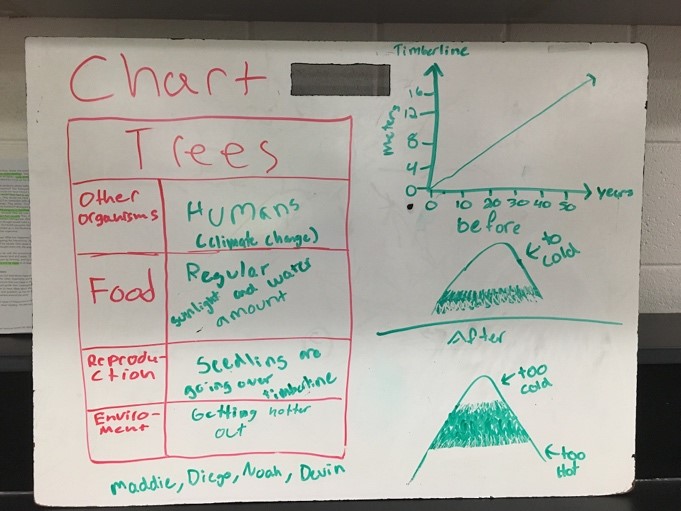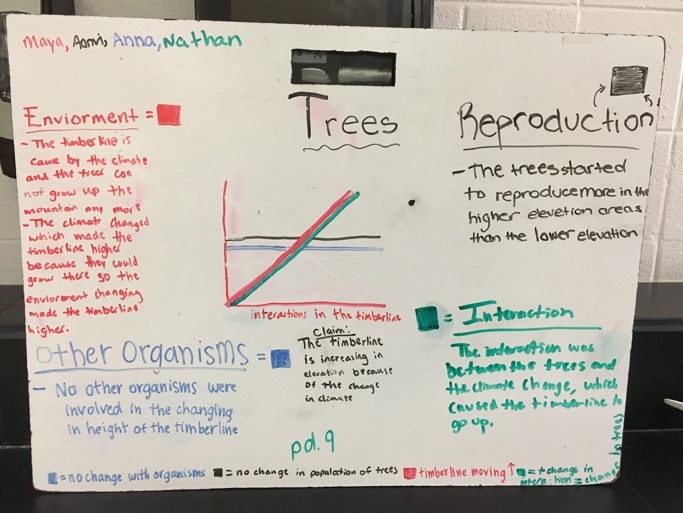Modeling How Students Can Share Ideas and Make Sense of Phenomena by Aaron Mueller
By Cindy Workosky
Posted on 2019-07-17
One of the most important steps I take to elicit student ideas in the classroom is to establish a classroom culture that makes students feel comfortable sharing their ideas. I take the time to develop a strong, receptive culture at the beginning of the year, to support students sharing their ideas throughout the year.
One way I establish a culture that welcomes sharing ideas, thinking, and making sense of phenomena is by capitalizing on students’ natural love of “figuring things out” using a fictitious board game that students don’t know the rules for. I use a game from the American Modeling Teachers Association that students haven’t played. Their task is to make sense of the game board, including game moves and results; figure out the rules; and understand the game’s purpose.
During this process, students tend to become less anxious in the science classroom and rely more on their background knowledge of traditional board games. Many students engage in dynamic negotiations of how they believe the game should be played and consequently lose any fear they may have of sharing ideas in class. They start perceiving themselves as confident defenders of their sense-making. This becomes a model for how students will share ideas and question others’ understanding, and prepares them to engage in sense-making in the context of a phenomenon.
This approach also gives me the opportunity to model with them how they will drive our learning in the classroom, and encourage them to share ideas and negotiate their thinking with the class. When students are comfortable sharing ideas in a low-stakes setting, they are able to transfer these strategies to a phenomenon.

My first unit of study is ecosystems. I use as an anchoring phenomenon the reintroduction of the grey wolves into Yellowstone National Park. I show a video, muting specific dialogue by the narrator that reveals how Yellowstone’s ecosystem changed due to the reintroduction of the wolf. This makes the students use their inferring skills, background knowledge, and personal experiences when visiting Yellowstone to make sense of what was missing. When my students watch the video, they immediately have questions. Now, I have them hooked!
One way I elicit and record students’ questions is by using a Driving Question Board (DQB). Student DQBs are dependent on choosing the right phenomena and framing the phenomena so that students have questions and develop the need to know.
In one lesson, students are presented with three different organisms and explore their interactions with the environment, another organism, or both. Students develop arguments on their whiteboards using the Claim, Evidence, and Reasoning (CER) framework to make sense of how an organism interacts with the environment or another organism. Students compare their whiteboard CERs and negotiate with one another to determine which argument has stronger evidence.


Using the whiteboard empowers students to drive the questioning and sense-making in the classroom. The groups create a class consensus based on the negotiating that took place, and my role is to facilitate and record evidence that leads to the consensus decision while they look to their peers for support.
The process of eliciting students’ ideas, sharing their thinking, and sense-making takes time. As the year progresses, students sometimes challenge me to return to the teacher-driven learning process. If this happens, we play another fictitious game to help them develop a more positive mindset about sharing their ideas and sense-making without first having the science content. The best part is students realize and appreciate midway through the year the value of making sense of what they are experiencing instead of just being given or told what to learn. You can see the students’ willingness to take more risks in sharing their thinking as the year progresses.
How do you begin a school year, a new unit, and/or a lesson to encourage students to share their ideas or thinking? How do you feel about the students “driving” the conversations or negotiations? Each new year, unit, and lesson is different for each student. I would love to hear from you about how you have developed a classroom culture of students sharing their thinking and making sense of phenomena.

Aaron Mueller has taught science for 19 years at Scullen Middle School in Naperville, Illinois. He is a member of the Achieve, Inc., Peer Review Panel; a member of the NSTA Cadre for facilitating professional development in three-dimensional instruction and assessment; and a workshop facilitator in Middle School Science Modeling with the American Modeling Teachers Association (AMTA). In addition, Mueller was a finalist in the Presidential Awards for Excellence in Mathematics and Science Teaching for Illinois in 2017. He enjoys spending time with his family, coaching track and field, and enjoying the great outdoors.
Note: This article is featured in the July issue of Next Gen Navigator, a monthly e-newsletter from NSTA delivering information, insights, resources, and professional learning opportunities for science educators by science educators on the Next Generation Science Standards and three-dimensional instruction. Click here to sign up to receive the Navigator every month.
Visit NSTA’s NGSS@NSTA Hub for hundreds of vetted classroom resources, professional learning opportunities, publications, ebooks and more; connect with your teacher colleagues on the NGSS listservs (members can sign up here); and join us for discussions around NGSS at an upcoming conference.
The mission of NSTA is to promote excellence and innovation in science teaching and learning for all.
Future NSTA Conferences
2019 National Conference
STEM Forum & Expo
2019 Fall Conferences
Disclaimer: The views expressed in this blog post are those of the author(s) and do not necessarily reflect the official position of the National Science Teaching Association (NSTA).
Teaching Strategies Middle School


